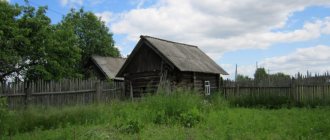Whose property is the public land of the gardening non-profit partnership
Whose property is the public land SNT
It is known from the media that many local administrations, in particular municipal administrations, manage the public land of members of gardening non-profit partnerships. Right, is this legal? This question is not at all idle or petty. Land has always been and is today the subject of speculation and corruption.
Until December 27, 1991, land in Russia was public property.
12/27/1991 President of the Russian Federation B.N. Yeltsin issued decree No. 323 “On urgent measures to implement land reform in the RSFSR.”
In 1992, local administrations, in pursuance of this decree, by their resolutions secured (precisely assigned, and did not re-allocate) the ownership of existing land plots in gardening partnerships and issued a standard document, which was called “Certificate of ownership of land for perpetual (permanent) use earth." Such certificates were issued to all members of gardening partnerships according to the submitted lists from gardening partnerships to local administrations on their individual land plots and to legal entities, chairmen of the boards of these gardening partnerships on collective public land.
Subsequently, many laws were adopted on property ownership, including land, in particular the Land Code of the Russian Federation of October 25, 2001. All laws, norms and rules are systematically and regularly supplemented, changed and mainly in the interests of the ruling bureaucracy. Various land relations organizations were created, liquidated, and renamed. But local administrations in a number of regions have managed and continue to manage the common use land of members of gardening partnerships today.
According to the current Constitution of the Russian Federation, Article 8, paragraph 2. “In the Russian Federation, private, state, municipal and other forms of property are recognized and protected equally. Article 9, paragraph 2 “Land and other natural resources may be in private, state, municipal and other forms of ownership.”
Question.
What form of ownership does the public land of horticultural non-profit partnerships belong to: state, municipal, or some other form of ownership? Specifically, who is the owner of public lands in horticultural non-profit partnerships, and who has the right to dispose of them?
Common joint ownership of land
The right of common joint ownership is regulated by Art. 253 of the Civil Code of the Russian Federation, according to which all participants in this legal regime can jointly own and use common property (land), unless otherwise provided by an additional agreement. A land plot that is in common joint ownership can be disposed of by any of the participants, with the consent of all other parties. For example, the procedure for owning, using and disposing of farm land is determined by an agreement between persons who have expressed a desire to create and operate a joint farming enterprise.
At the same time, the authority to dispose of a farmer's land plot is given to its head in the interests of running a farm. Each of the participants in joint ownership has the right to enter into various transactions to dispose of the common property, while the completed transaction may be declared invalid on the basis of claims made by other participants regarding the lack of certain powers of the party who made the transaction. The division of common property between the participants in joint ownership or the allocation of the share of one of them is carried out after the preliminary determination of the share of each of the participants.
The division of common joint property requires equal shares for all participants (Article 254 of the Civil Code of the Russian Federation).
The legal regime of common joint property is clearly described in Art. 256 of the Civil Code of the Russian Federation (common property of spouses). Thus, property acquired by spouses during marriage is their joint property, with the exception of certain cases provided for in the marriage contract. At the same time, property that was acquired by one of the spouses before marriage or received as a gift or by inheritance during marriage is his property. Based on Russian legislation, joint ownership arises in relation to:
- peasant farms;
- common land plots that were acquired through targeted contributions from members of gardening and dacha non-profit partnerships;
- common property of the spouses, unless otherwise provided by the marriage contract;
- joint ownership of citizens who are members of gardening and dacha non-profit associations, subject to the provision of a land plot on payment terms.
Privatization of public land in SNT
Lawyer's answer to the question: privatization of common lands in the SNT; this property is the property of all members of the SNT and its privatization is not necessary. This property should be on the balance sheet of the organization ———————————————————————— I have been using a plot of land from public land (PLL) in SNT since 1993.
In addition, only the redistribution of these lands into the private ownership of SNT members will not allow the local administration of the urban settlement of Povarovo to withdraw these as being used for other purposes and transfer them, for example, for rent to businessmen, in the event of further annexation of SNT "Solnechnoye" to the lands Mikhailovka village.
We recommend reading: State Duty Amount for Passport Theft in 2019
Privatization of land in SNT
Often this concept is used when it is necessary to indicate the legal status of a piece of land, namely its permitted type of use and ownership. Knowing the status of a plot will allow a citizen buying land to avoid being deceived by a seller who is not the owner of the plot.
- a certificate certified by the management of the Board stating that the applicant owns the land plot subject to privatization;
- a copy of the partnership member’s book certified by the management of the Board;
- a copy of the general plan of the partnership;
- a copy of the minutes of the General Meeting with the decision to admit a citizen to the partnership.
Use of public land in SNT
Usually the site is provided for temporary use free of charge. But in some cases, chairmen impose a certain social burden on the applicant. For example, they demand that vegetation be trimmed.
We recommend reading: Is it possible to withdraw an item if it has not been paid for?
When making decisions, the board will be guided by the interests and legal rights of the members of the partnership. For example, if an applicant plans to install a toilet or shower there, then he is more likely to be refused.
What does the law say about common ownership?
The legal concept in question is enshrined in the Civil Code of the Russian Federation in Chapter 16. This section is devoted to the general rules of interaction between citizens who own property jointly.
The root of the problem lies in the inability to separate certain objects. For example, if a real estate property is located on a plot of land.
The division of the territory will lead to the fact that the building will be on the part belonging to one person, while the other will receive nothing. Otherwise, the border of the new plots will pass under the building, which will lead to a new dispute.
Also, the Town Planning Code of the Russian Federation establishes maximum minimum sizes of plots. Therefore, not all plots can be divided into independent objects.
The right of ownership presupposes that a person has 3 possibilities: to own, use and dispose of a certain object at his own discretion.
Use may be as follows:
- cultivation of land;
- use of useful properties of the site;
- planting;
- construction of structures;
- other events.
The law provides that such actions should only be carried out with the consent of all property owners. In its absence, interested parties must go to court.
Property may be divided into shares or used without such division. Determination of shares is not provided, for example, for part of the land of horticultural and dacha cooperatives: roads, territories occupied by water bodies, etc.
The share has limited negotiability. The owner can give it as a gift, bequeath it, or use it as collateral. Sale is possible only if the other owner is notified in a timely manner. The transaction is carried out if all other owners refused to use their preemptive right to purchase.
Sample agreement on the procedure for ownership and use of land:
You can determine the value of a land plot by cadastral number in Rosreestr. Next, we will tell you where you can find out the cadastral value of a land plot.
Privatization of Public Land in St. Petersburg in 2020
2.) Algorithm of actions: general meeting> cadastral work> approval of documents in the administration> cadastral registration> registration of rights. Regulatory legal acts that regulate this issue: 221 Federal Law “On the State Real Estate Cadastre” For the collection and registration of public lands of the SNT, see
You must first request in writing from the chairman an extract of the minutes of the SNT meeting at which the issue of alienation of the PDO was decided. Neither the rights of the SNT board nor its chairman have the authority to dispose of the PDO.
Cost of privatization of a land plot in SNT in 2017-2018
At the same time, according to Art. 252 of the Civil Code of the Russian Federation, a participant leaving the partnership may demand the allocation of his plot from the shared ownership of the organization. If the allocation of land is impossible due to the fact that it entails loss to the remaining members of the partnership, the person has the right to monetary compensation for the cost of the land zone from other members of the legal entity.
Rosreestr bodies are authorized to make decisions regarding cadastral valuations. They appoint an executor from among self-regulatory assessment organizations, which must meet strict legal requirements.
The procedure for drawing up an agreement for the joint use of a land plot
First of all, all persons who have rights to a property must complete documents with Rosreestr. The authorized person must issue each person an extract from the Unified State Register, which will clearly indicate the size of his share.
Next, a situation arises when one of the owners understands that further ownership of the site is possible subject to an agreement. After this, all interested parties are invited to negotiate.
As a rule, the contract stipulates several aspects:
- incurring expenses;
- site maintenance;
- who will use what part of the territory at their discretion;
- the procedure for using communications;
- operation of common property (for example, outbuildings).
A sample agreement on the joint use of a land plot can be downloaded from the profile website and its provisions can be changed at the discretion of the parties. For this purpose, computer resources are used. In 2020, almost everyone has the opportunity to edit a text file on their own. If you have any questions, you can refer to the norms of the Civil Code of the Russian Federation.
A situation is possible when the owners actively use the common area. In this case, you may need to consult a lawyer who will suggest the most convenient and effective way of interaction. Also, inviting an outside specialist will help get rid of the emotional component of the relationship.
There is no need to register the agreement anywhere. After signing the agreement, the parties are obliged to adhere to its provisions. Otherwise, citizens may resort to judicial protection and demand financial compensation.
If the parties cannot reach a consensus, then the only option is to go to court. This government body has the right to establish a regime for the use of common ownership, based on established practice, the need of each owner and the size of shares.
The court decision is binding. If the provisions of the document are violated, interested parties have the right to contact bailiffs.
Sample extract from the Unified State Register of Land Registers for a land plot









